Key takeaways:
- Culinary education encompasses not just recipe learning but also understanding food’s cultural significance and emotional connections.
- Documenting food traditions involves engaging with community, sharing stories, and understanding the historical contexts of dishes.
- Food history fosters community bonds and identity, providing a narrative that enriches personal and collective experiences.
- Sharing research and findings about food enhances community understanding and appreciation for culinary heritage and tradition.
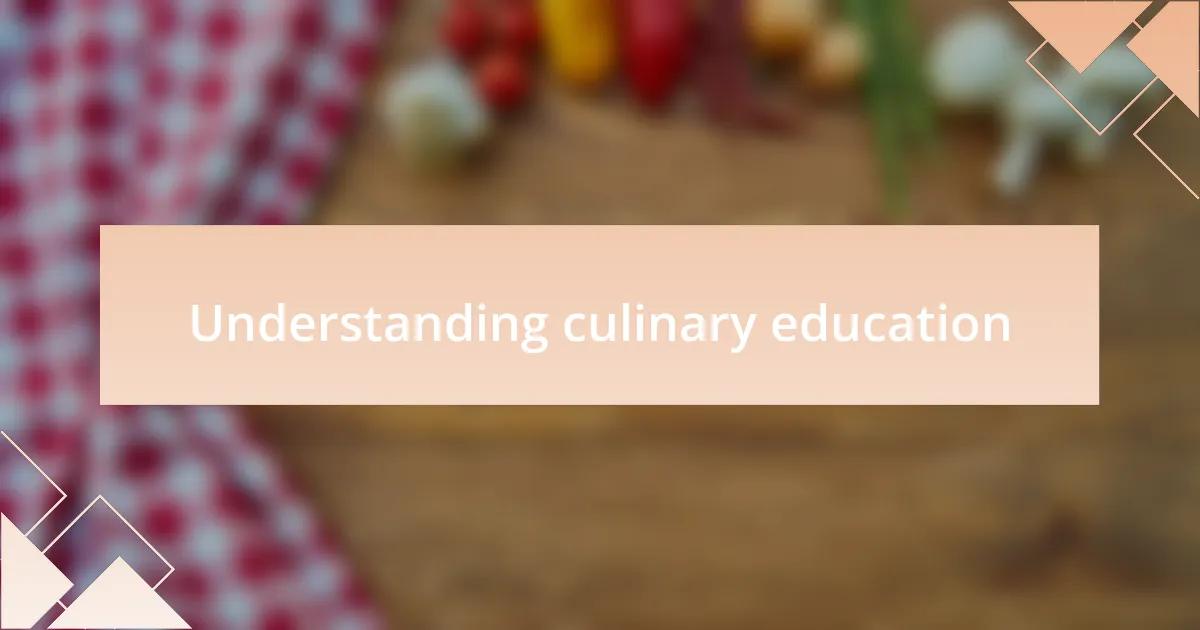
Understanding culinary education
Culinary education goes beyond simply learning recipes; it’s about understanding the cultural significance of food and how it connects us. I remember my first cooking class, where the instructor shared stories behind each dish. Those narratives transformed the mundane act of cooking into a journey through history—a glimpse into the lives of those who created these recipes.
The variety in culinary education is striking. From hands-on training in professional kitchens to exploring food science, each facet offers something unique. Have you ever considered how food not only nourishes our bodies but also our emotions? I often reflect on how certain ingredients can take me back to cherished moments, like the aroma of fresh basil reminding me of my grandmother’s garden.
Furthermore, culinary education encourages creativity and self-expression. It’s not just about following steps in a cookbook; it’s about experimenting and finding your own voice in the kitchen. In my experience, the most rewarding moments come when I take a traditional dish and add a personal twist. What about you? When was the last time you stepped out of your comfort zone in the kitchen?
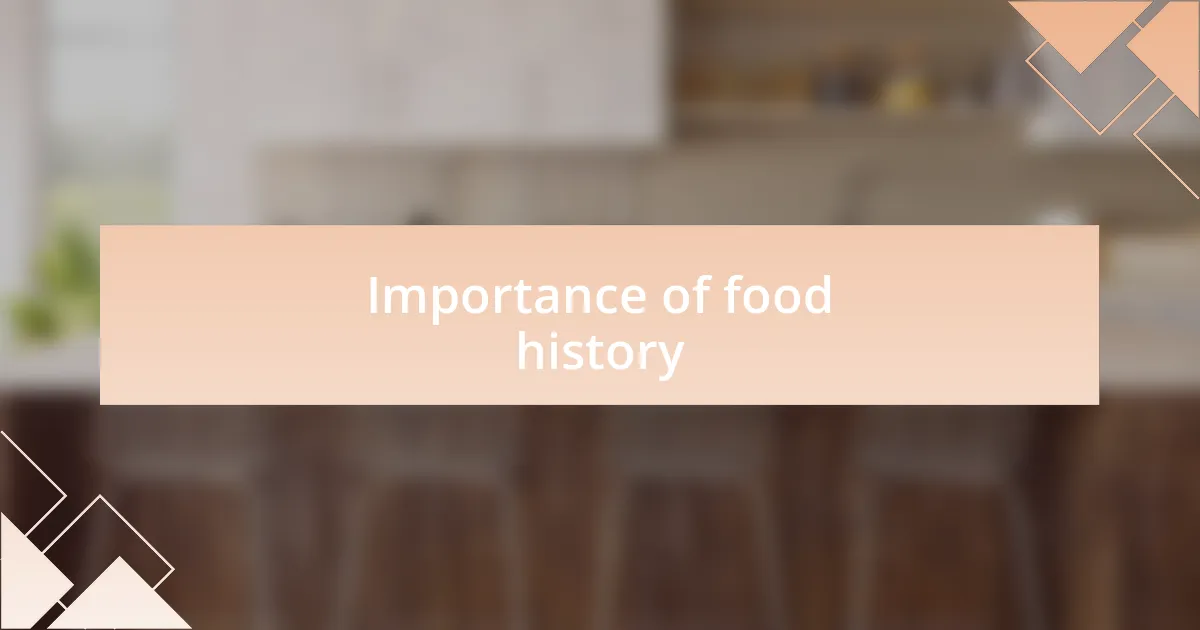
Importance of food history
Food history serves as a vital lens through which we can understand our culinary landscape. I often find myself captivated by the stories behind regional dishes, like how a particular spice blend emerged from cultural exchanges along trade routes. Isn’t it amazing how a simple meal can reflect centuries of history and adaptation?
Digging into food history also uncovers the traditions that shape our identities. For instance, when I learned about the rituals surrounding Thanksgiving dishes, it deepened my appreciation for the meal itself. It posed a question: how do our family traditions in cooking serve as threads weaving the fabric of our heritage?
Moreover, exploring food history fosters a sense of community and connection. I remember attending a local food festival where each booth shared tales of culinary lineage and pride. It made me realize how food not only feeds us but binds us in shared experiences—what better way to strengthen bonds than through the stories we inherit on our plates?
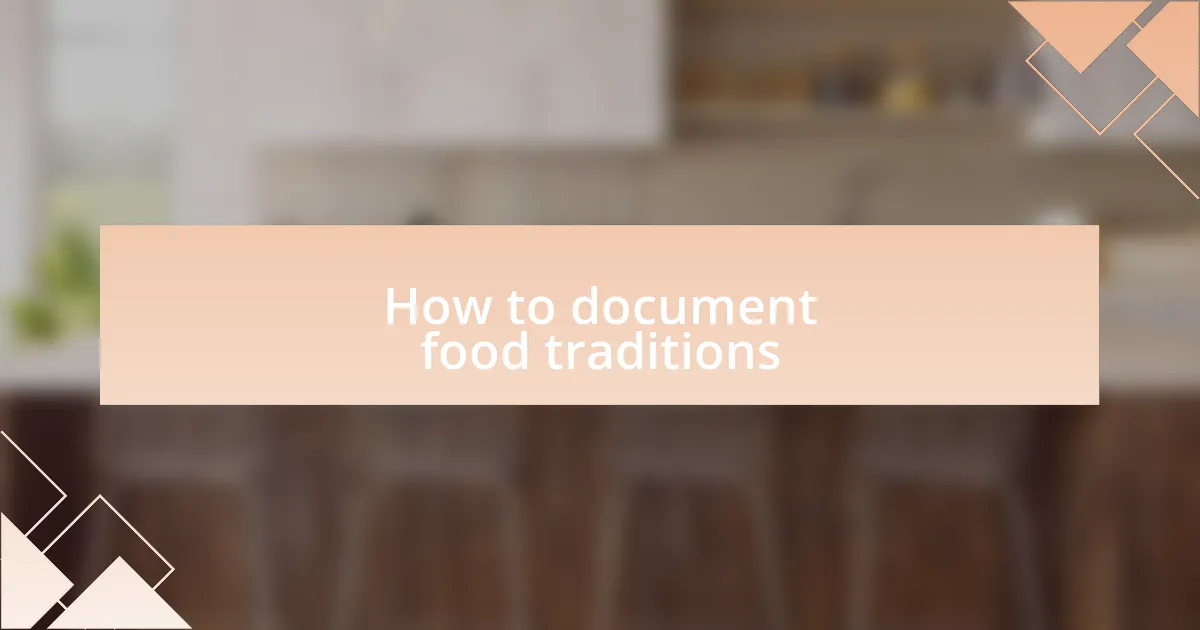
How to document food traditions
Documenting food traditions requires an attentive ear and an open heart. Personally, I’ve always found that conversations with elders reveal the richest stories, often colorful and filled with nostalgia. Have you ever listened to someone describe their grandmother’s secret recipe? Those moments are more than just recollections; they’re windows into a world of flavors, feelings, and familial bonds.
When I began recording regional recipes, I developed a system of interviewing community members alongside collecting handwritten notes. Each gathering became a mini food festival in itself, with laughter, snippets of history, and dishes that sparked joy. This participatory approach not only preserved the recipes but also cultivated a sense of belonging, emphasizing that food traditions thrive best when shared with others.
It’s also essential to pay attention to the contextual details that surround the food. For example, while documenting a beloved local stew, I realized that the ingredients changed based on seasons and availability. This flexible approach reflects the environment and economy of the region. How does your local cuisine adapt over time? Exploring these shifts not only enriches our understanding of food traditions but also illustrates the resilience of communities.

Techniques for interviewing food experts
When interviewing food experts, listening is just as crucial as asking the right questions. I remember sitting with a local chef who had spent decades perfecting his craft; instead of jumping straight to the specifics of his signature dish, I let him reminisce about his culinary journey. This allowed me to gather not only recipes but also the emotional connections he had with each ingredient. Isn’t it fascinating how passion can elevate a simple meal into a story worth telling?
Building rapport is essential in these conversations; it creates a comfortable environment where your interviewee feels valued. During a recent chat with a food historian, I found that sharing a personal anecdote about my own family gatherings made him open up about his favorite regional practices. These connections transform the exchange from a standard Q&A to a meaningful dialogue that uncovers deeper insights into culinary history. Have you tried sharing a piece of your story when speaking with an expert? It may unlock information you didn’t even know existed.
Finally, don’t forget to document the nuances – the laughter in their voice, the sparkle in their eyes when they talk about a cherished dish. I often take a moment to pause after a particularly engaging response, allowing the atmosphere to settle. It’s in these silent moments that the most profound stories often emerge. How do you capture the spirit of what you’re learning? Treating each interview as a shared experience can lead to unexpected treasures in your research.
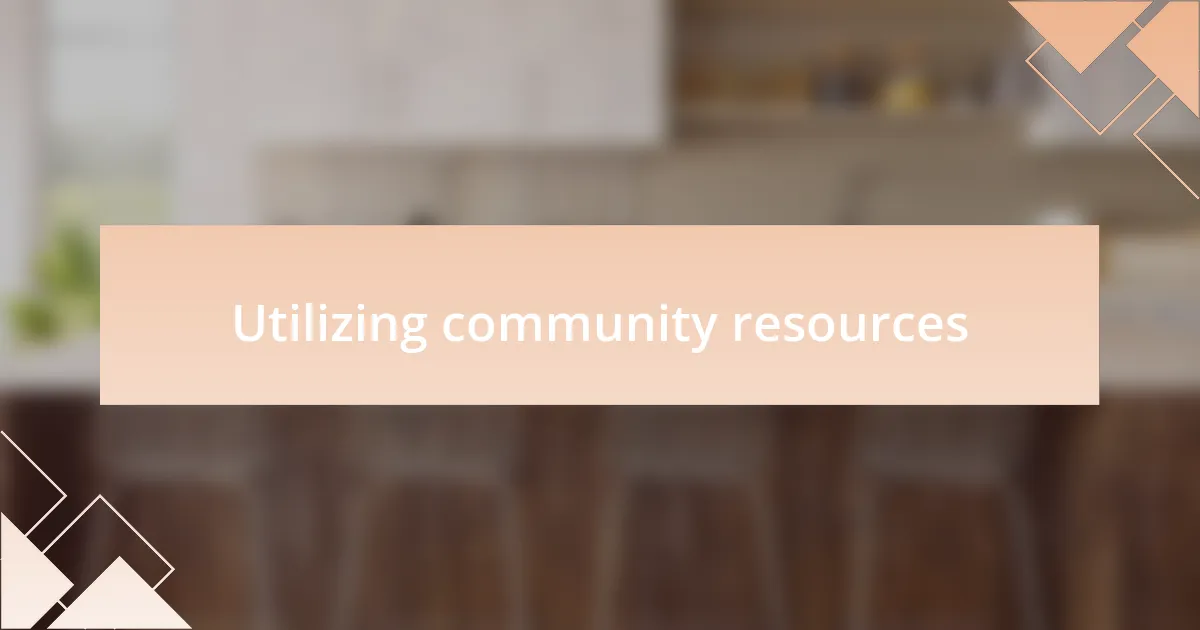
Utilizing community resources
When it comes to documenting regional food history, utilizing community resources can dramatically enhance the richness of your findings. I often turn to local libraries and cultural centers, where the archived materials reveal unexpected gems. For instance, I stumbled upon a collection of handwritten recipes from a community potluck in my hometown, each recipe accompanied by notes that recounted the stories behind them. Have you ever explored such hidden archives? They can provide a sense of connection to the past that truly enlivens your research.
In my experience, engaging with local community groups can also yield invaluable insights. I joined a gardening club where members swap heirloom seeds and stories about their agricultural practices. One member shared how her grandmother’s kitchen garden influenced local recipes, and suddenly, I found myself with a tapestry of cultural influences woven through food. Isn’t it amazing how conversations about a simple tomato can lead to discovering the historical significance of an entire community’s approach to farming?
Moreover, attending local events such as food festivals or farmers’ markets opens up direct channels to the very essence of the culinary culture. I remember chatting with a vendor who not only sold traditional products but also shared the history of each item’s significance in the community. That moment made me realize that food is not just about what we eat; it’s a narrative deeply rooted in our shared experiences. How often do we overlook the stories that accompany the foods we cherish? Engaging with these community resources can reveal a treasure trove of information that breathes life into the history you’re documenting.
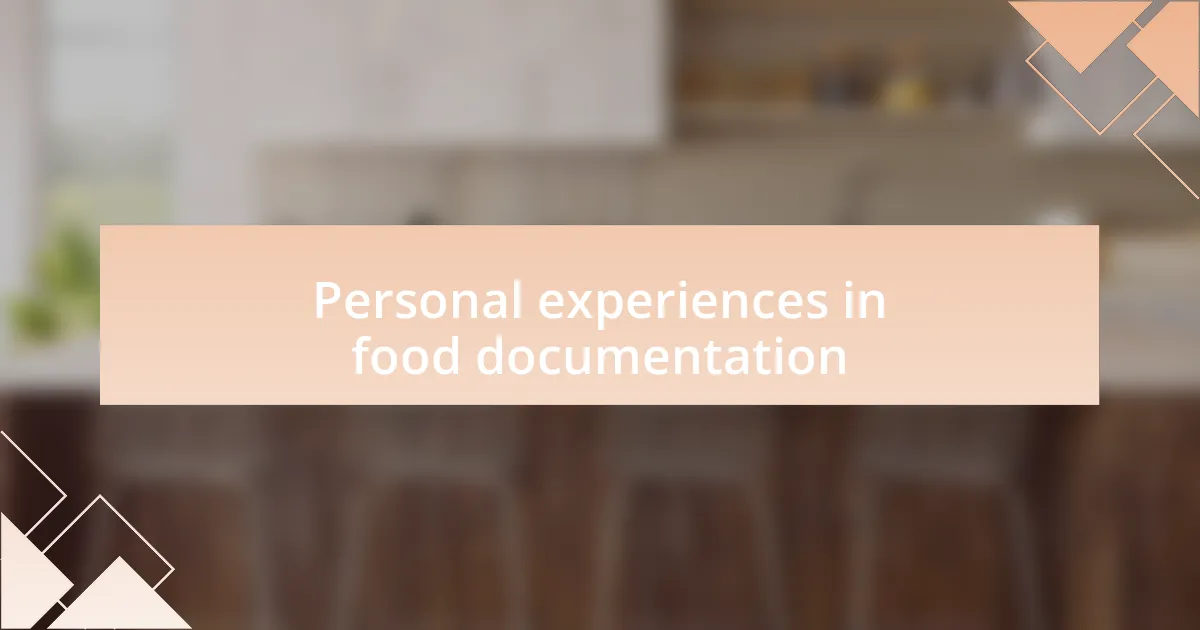
Personal experiences in food documentation
Documenting food history has often led me to unexpected encounters that changed my perspective. I vividly recall a warm afternoon spent in a small café where the owner invited me to the back kitchen. As we sat together, she shared not just recipes but the emotional weight behind each dish. How does one biscuit recipe hold the laughter of generations? It amazed me how food can serve as a vessel for nostalgia.
One particularly rewarding experience came from a storytelling event focused on family recipes. Participants were encouraged to share not just how to make a dish, but the memories tied to it. Listening to the tale of an elderly gentleman who inherited his mother’s recipe for buttermilk pie was like stepping into a time capsule. Have you ever experienced food through the lens of someone else’s cherished traditions? His reminiscences made me realize that food documentation is as much about the stories as the culinary techniques themselves.
In another instance, I participated in a community harvest day and found myself surrounded by diverse individuals, each bringing their unique touch to traditional dishes. I noticed how a simple corn stew could carry flavors and stories from various cultures. Isn’t it fascinating how something as humble as a bowl of stew can be a reflection of migration and adaptation? These experiences are reminders that food history isn’t just about ingredients; it’s a living narrative that continues to evolve.

Sharing findings for impact
Sharing findings for impact can transform the collective understanding of regional food history. I remember presenting my research at a local farmers’ market, where I eagerly shared stories about the heritage of the crops being sold. The expressions of surprise and delight on people’s faces were unforgettable. It struck me then—how often do we stop to ponder the journey of our food from farm to table?
In another instance, I collaborated with a local school to create a workshop on traditional cooking. Sharing the historical context behind the dishes opened up new conversations among students and parents alike. Their enthusiasm in realizing the rich narratives tied to the meals they consume was truly inspiring. Why should history be confined to textbooks when it can be tasted and experienced?
Documenting and sharing these findings not only enriches personal knowledge but also strengthens community bonds. At a book club meeting, I shared how my research revealed the overlapping influences of migrant cuisines in our area. This sparked lively discussions that extended beyond recipes to touch on identity and belonging. Isn’t it rewarding to see how food can act as a common thread that connects diverse stories and experiences?